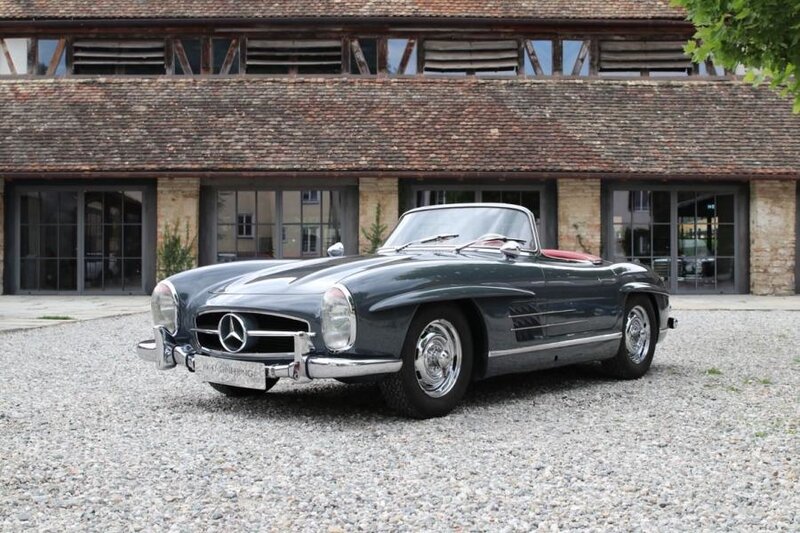Modern Classic: Mercedes-Benz 300SL ‘Gullwing’
The Mercedes-Benz 300SL Gullwing went into production in late 1954. Photos: Supplied
The Gullwing has become Mercedes-Benz’s most desirable collectible sports car, however this famed car is only part of the story!
The real name is the 300SL and came as both a coupe (with the gullwing doors) and a roadster (convertible) and as two model flavours being the cheaper 190SL (four-cylinder) and the 300SL.
Even more confusingly although released in 1954 at the New York International Motor Show as the “W198” model, it first saw the light of the day in 1951 as a race going “W194” model which won the 1952 Le Mans.
The 300SL began from an idea by American Max Hoffman who at a 1953 Mercedes Benz Directors’ meeting, said, “what we need over here (America) is a great Mercedes-Benz sportscar”.
To emphasise his point he placed an advance order for 1000 300SLs and 1000 190SLs. The 300SL was actually never meant to be put into volume production, but a positive response to its launch changed that.
The 300SL went into production in late 1954, in coupe (gullwing) form and was superseded in 1957 by the 300SL roadster. The 190SL roadster came into existence in 1955 and lasted all the way until 1963. The 190SL never made it into a gullwing version. A total of 1400 coupes were produced and 1858 roadsters, in 300SL guise, while around 25,881 190SL roadsters were built.
The Gullwing doors were essential due to its tubular frame.
The Mercedes W194 race car of 1951 had an M186 engine it shared with the W186 300 “Adenauer” sedan and the W188 300 S tourer, and had carburettors putting out 130kW.
The 300SL instead put out 158kW or 179kW, depending on the model guise, and had a top speed of 263km/h, via a Bosch mechanical fuel-injected, overhead cam straight six of 3.0 litres. The engine was tilted 50 degrees, to fit into such a low profile car. Unusually, the higher-powered engine could be ordered for free on the coupe, whereas the roadster got it as standard. The 190SL made do with a four-cylinder carburettor engine good for 77kW or 89kW, depending on the model, and this engine was a derivative of the straight-six in the 300SL.
The 300SL had an aluminium bonnet, doors, dashboard and boot lid. It had a tubular frame that weighed 82 kilograms and this made for a deep side panel, which made regular doors impossible to fit the car, hence the gullwing arrangement was not for aesthetics but for essential entry to the car.
The coupe only had storage room behind the front seats, since the boot was taken up with the spare wheel and fuel tank. The roadster could fit two pieces of luggage in its trunk. It even had unique “eyebrows” in its design which deflected water from the windscreen.
The 300SL convertible has leather as standard but was optional in the Gullwing.
Original coupes were sold with beautiful fabric patterned seats in three colours, and optional leather, whilst the roadster had leather only seats. The standard exterior colour was silver grey. Disc brakes were added in 1961, to replace the drum brakes, and these were well ahead of their time.
The 300SL’s fuel pump had a novel feature that kept petrol being injected after the ignition was switched off and the engine came to a stop, washing away petrol film which could excessively wear the engine.
The four-speed manual transmission had an unusually tall first gear, which made city driving particularly complex.
The decision to move from the coupe to roadster only in 1957 was on the back of falling sales of the former.
The 300SL roadster was geared for the California market and was 125kg heavier than the coupe, but used the 179kW engine. It had the same tubular frame as the coupe, but had regular doors, and was reconfigured to give a more spacious boot.
The 300SL roadster was popular in the California market.
Collectors of the 300SL operate in a global market and examples are now fetching well into seven figures, and will only rise.
Of most prized are the original gullwing examples and even more so are 29 all aluminium examples that saved 80kg of weight. Also “crazy” unique is the special 300SLS that was created in roadster form in 1957 with an enlarged 3.5-litre six-cylinder engine and a weight reduction of 280kg from the standard roadster model and a 175kW engine.
Personally, I still favour the simplicity of the 1963 Mercedes Pagoda although there is no denying the 300SL (and its sister the 190SL) are special cars, well ahead of their time.




